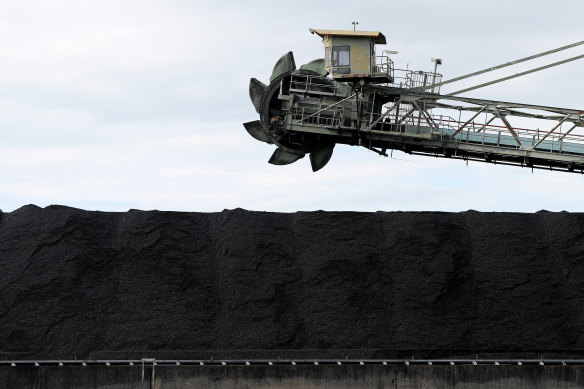By Nick Toscano
Australia’s biggest power station burnt more coal in the past 12 months than in any year since 2019, underscoring the difficulties of weaning the electricity grid off the polluting fossil fuel amid delays plaguing the renewable energy rollout.
The giant Eraring coal-fired generator on the shores of Lake Macquarie in NSW ramped up output by 2.1 terawatt-hours to 14.3 terawatt-hours in the year to June 30, the plant’s owner, Origin Energy, revealed on Wednesday.

The Eraring power station’s coal output has hit a five-year-high, highlighting the difficulties of weaning the grid off the polluting fossil fuel.Credit: Bloomberg
The increase was driven by the NSW government’s emergency decision to cap the price of black coal last year in a bid to spur greater power supply and shield consumers from the worst impacts of rising energy costs following Russia’s invasion of Ukraine.
Origin chief executive Frank Calabria said Eraring’s increased output supported policies intended to boost generation and “put downwards pressure on electricity prices”.
“Origin’s generation fleet performed strongly during the year, with high levels of reliability,” Calabria said.
Coal has been the backbone of Australia’s electricity market for more than half a century, but the fossil fuel is also a dominant source of greenhouse gas emissions that are dangerously heating the planet.
The United Nations wants rich countries to phase out coal by as soon as 2030 to help avert the worst impacts of global warming. The Albanese government’s legislated target to slash emissions by 43 per cent by 2030 relies heavily on replacing coal plants with more wind, solar and hydropower.
However, the accelerating closures of coal-fired generators has become a cause of concern for grid planners and state governments amid worries that not enough renewable energy generators, storage projects and transmission lines are being built in time to avert the threat of blackouts or price spikes.
Origin, which had originally planned to bring forward the retirement of the 2880-megawatt Eraring generator in August, struck a deal with the NSW government earlier this year to keep the plant running until 2027. Under the deal, Origin can be compensated up to $225 million a year if the plant runs at a loss, and will pay the government a portion of its operating profits, capped at $40 million, if it makes money.
Coal-fired generators across the grid, including Eraring, have been running harder over the past quarter after a prolonged stretch of cold weather drove up energy demand from household heaters, while a wind drought curtailed output from wind turbines.
Despite the grid’s ongoing reliance on the fossil fuel, the challenges of continuing to run coal-fired power stations were also revealed on Wednesday as Origin raised the provisions in its accounts to cover Eraring’s remediation by approximately $235 million. Following the expiry of the $125-a-tonne coal price cap in NSW, Origin also flagged an increase in coal costs this year of $30 a tonne, more than some analysts had been expecting.
Macquarie analyst Ian Myles said the $200 million cost increase for the remediation of the plant and its ash dam, alongside the $35 million increase for higher material, contractor and consultant rates, marked a 39 per cent “step-up” to the existing provision.
“The size reflects expansion of scope, early drawdown on the power station needs and inflation,” Myles said. “This is arguably disappointing, but a risk that is hard to extinguish until closure.”
Myles described Origin’s June quarter results as “solid” across the company’s energy markets division and its upstream gas production joint venture in Queensland, Australia Pacific LNG (APLNG).
APLNG’s sales revenue rose 2 per cent from the prior quarter, the company said, while softer commodity prices drove a 12 per cent decline in full-year revenue.
The Business Briefing newsletter delivers major stories, exclusive coverage and expert opinion. Sign up to get it every weekday morning.